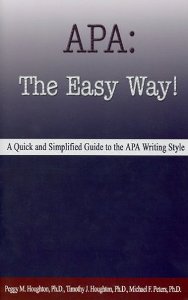|
APA ReferencingAPA Referencing Many students underestimate the importance of referencing but from an academic perspective, referencing is vitally important. The cornerstone of any academic writing be it a term paper, essay, research project or dissertation is the dissemination of ideas. References, i.e., source material based on the views, opinions and research findings of others provide the conceptual framework necessary to engage in analytical debate. Imagine you had to write an answer to the following question without references. Criminal Profiling is Unscientific: Discuss Impossible. However, passionate or valid your personal view on the topic is i.e. I disagree, I actually think criminal profiling is scientific because... I'm afraid from an academic perspective an unsubstantiated personal opinion is not worth the paper it's written on. This is why the convention within academia is to write in the third person. A key aspect of referencing that students tend to overlook is the fact that they allow the reader to identify, access and use the material themselves. It also crucial to reference properly so that there can no possible suggestion of plagiarism i.e. taking and using the writings of others and passing it off as ones own. Plagiarism is an extremely serious offence and can result in a student been expelled if found guilty. When you begin your school, college or University course you should at some point (usually in the first week) be given specific guidelines on the standard referencing style required. In most cases this will be the APA referencing format. Make sure you have these guidelines to hand whenever you do any form of academic writing. It's the best form of referencing quality control you can have.
Most Common APA Style Referencing MistakesWithout doubt the most common APA referencing format mistakes relate to the increasing popular practice of obtaining source material via electronic means e.g. the Internet. Most Internet references will have been accessed via a specific web page, however, remember there are other Internet sources e.g. newsletters, online newspapers, e-books etc. APA style referencing guidelines suggest that an Internet source should provide a document title or description, a date (either the date of publication or update or the date of retrieval), an Internet address (URL) and Whenever possible, the author(s) of the source material as well. In a past edition of the all about forensic psychology newsletter, which can be accessed online, I included an article entitled what is forensic psychology based on the all about forensic psychology webpage of the same name. If a student used any of the information contained in the article as part of an academic assignment; bearing in mind the APA guidelines mentioned above, the correct APA Referencing format would be as follows: David, Webb (May 2006). What is forensic psychology? All about forensic newsletter 2. Retrieved from https://www.all-about-forensic-psychology.com/ A full account of all the APA guidelines extends beyond the confines of this webpage, however, if you go to the all about forensic psychology student free stuff page, you can download the Student's Guide to APA Psychology for free.
Number One APA Referencing TipWhenever you do an academic assignment make sure you write down the full reference of each source as you find it. Many students, including myself in the past, fail to do this. Taking notes from the source for possible inclusion in the written assignment is fine but if you do decide to use the material, you can find yourself wasting hours of your valuable time trying to remember the name of the book you returned to the library etc. This problem is particularly acute when students are doing a thesis or dissertation, involving literally hundreds of references. Writing references as you go along may mean you record a host of references that you don't actually end up using, however, the time wasted doing this pales into significance compared with the alternative. Essential APA Referencing ReadingAPA: The Easy Way! By Peggy M. Houghton & Timothy J. Houghton
Book Description This handbook is a quick and simplified guide to the APA writing style. It was developed as a condensed version of the official APA Publication Manual and designed to be utilized as a supplement to the actual guide. The handbook is divided into three parts. Part one focuses on the mechanics of APA format as well as internal text citations; part two emphasizes the actual reference page entries; and part three provides a sample paper. See following link for more details: UK Visitors Click Here |
